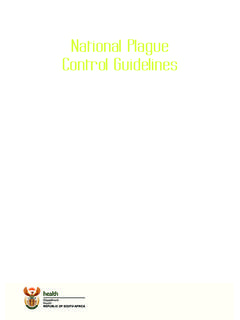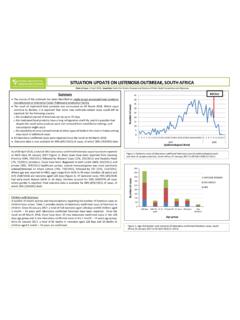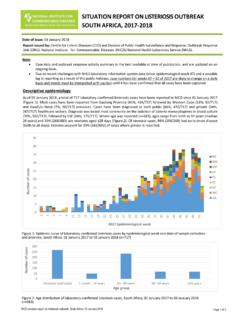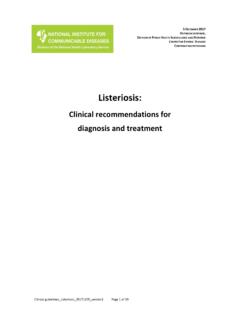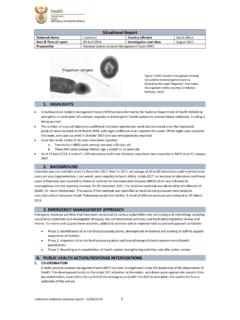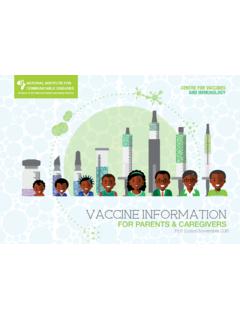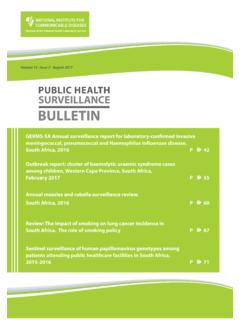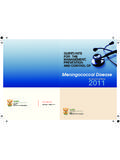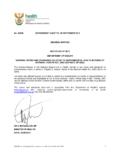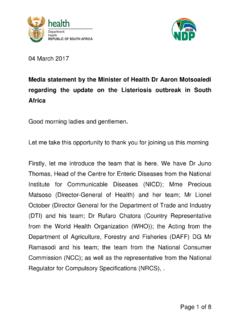Transcription of Draft National Infection National Infection Prevention and ...
1 0 Draft National Infection Prevention and Control Strategic Framework March 2020 National Infection Prevention and Control Strategic Framework 0 Foreword Many medical practices and risks associated with health care are emerging as major challenges for patient safety and contribute significantly to the burden of harm due to unsafe care. Health care-associated infections (HAIs) are one of the frequently encountered patient safety incidents in care delivery and poses major public health challenge impacting on morbidity, mortality and quality of life. The prevalence of HAIs in mixed patient populations in low- and middle-income countries (LMICs) is approximately twice that of high-income countries. These infections also present a significant economic burden at the societal and health facility level. Effective Infection Prevention and control (IPC) programmes have been proven to be one of the cornerstones for combating HAIs and antimicrobial resistance (AMR).
2 There was therefore a need to align the National IPC Policy and Strategy (2007) to the World Health Organization s (WHO) core components for IPC (2016). With the recent promulgation of the Regulations for Norms and Standards applicable to different categories of health establishments (2018), which include standards for IPC, a policy document is no longer required to ensure that IPC principles are adhered to. Therefore, this strategic framework gives guidance to public and private health facilities and health workers on compliance with standards relating to IPC practices. To further assist health facilities to implement this IPC strategic framework, a practical implementation manual has been developed in parallel to accompany this document. I believe and trust that this strategic framework and the practical manual for implementation of the strategic framework will strengthen evidence-based IPC practices at National , provincial, district and health facility levels towards: combating threats posed by epidemics, pandemics and AMR; and achieving the WHO Sustainable Development Goals 3 and 6 incompliance with the International Health Regulations.
3 0 ACKNOWLEDGEMENT My sincere gratitude to the chairperson of the technical working group, Prof. Shaheen Mehtar, who led the development of the IPC strategic framework and practical implementation manual. Her dedication throughout the development of the document is highly commendable. I sincerely thank the members of the technical working group-Ms Ronel Steinh bel (co-chair), Ms Yolanda van Zyl, Ms Bri tte du Toit, Ms Belinda Makhafola and Dr. Shaidah Asmall- for their invaluable expertise. A special word of thanks is also extended to members of the various National committees, such as the National District Health Systems Committee, National Hospital Coordinating Committee, the Senior Management Committee and the Ministerial Advisory Committee for Anti-microbial Resistance who provided valuable inputs on the first Draft . My gratitude to the representatives of the private and public health sector and clusters within the National Department of Health (Primary Health Care and Hospital systems, HIV, Maternal health, TB), academic institutions, professional bodies, the National Institute for Communicable Diseases (NICD) and the National Health Laboratory Services (NHLS) who attended the National consultative meeting.
4 The valuable inputs made during the workshop were used to refine the final document. Lastly but not the least, I express special appreciation to the World Health Organization for the technical support provided throughout the development of the document, especially Dr Rajesh Narwal from WHO country office-South Africa, Dr Gertrude Avortri, Mr Nino Dayanghirang and Dr Juliet Nabyonga, from WHO regional office for Africa and Dr Benedetta Allegranzi and Mr Anthony Twyman from WHO Headquarters. WHO-South Africa s support for the final lay-out and technical editing of the document and hosting of the National consultative workshop is also much appreciated. 1 TABLE OF CONTENTS 1. Introduction .. 6 2. Purpose and 8 3. Scope .. 8 4. Legislative and strategic mandates .. 9 5. Situational analysis .. 10 6. Principles of the strategic framework .. 15 7. Core Infection Prevention and control components .. 16 Core component 1: Infection Prevention and control programmes.
5 17 Level 17 Provincial Level 20 Health Facility Level 22 Core component 2: National and health facility level Infection Prevention and control guidelines .. 24 Core component 3: Infection Prevention and control education and training .. 24 Core component 4: Healthcare-associated Infection surveillance .. 27 Core component 5: Multimodal improvement strategies for implementing Infection Prevention and control activities .. 28 Core component 6: Monitoring, evaluation and feedback .. 28 Core component 7: Workload, staffing and bed occupancy at the health facility.. 29 Core component 8: Built environment, materials and equipment for Infection Prevention and control at the health facility .. 30 LIST of FIGURES Figure 1: Overall IPCAF scores for private and public sector hospitals .. 14 Figure 2: Visual representation of the core components of IPC programmes .. 17 Figure 3: Relationship between the National IPC committee and the other stakeholders.
6 18 Figure 4: Reporting lines between MAC-AMR and other committees .. 20 Figure 5: Structure for a National IPC curriculum for South Africa .. 26 Figure 6: Relationship between the built environment, WASH and IPC & AMR .. 31 LIST OF TABLES Table 1: Legislative and strategic mandates .. 9 Table 2: Ideal Health Facility data: Results for IPC and Hygiene and Cleanliness .. 11 Table 3: Results from the WHO Global IPC Assessment Framework .. 13 Table 4: Interpretation of score ranges for IPCAF .. 14 Table 5: Staff category to be trained and duration of training .. 26 Table 6: Average length of stay and inpatient bed utilisation rate in public health facilities .. 30 2 Abbreviations AMR Antimicrobial resistance CDC Centers for Disease Control and Prevention CPE Carbapenemase-producing Enterobacteriaceae SSD Sterile Services Department EMS Emergency medical services ESBL Extended-spectrum beta-lactamase ESKAPE Enterococcus faecium, Staphylococcus aureus, Klebsiella pneumoniae, Acinetobacter baumannii, Pseudomonas aeruginosa, and Enterobacter species GLASS Global Antimicrobial Resistance Surveillance System HAIs Healthcare-associated infections IHR International Health Regulations IPC Infection Prevention and control IPCAF Infection Prevention and control assessment framework JEE Joint External Evaluation MAC Ministerial Advisory Committee MDROs multi drug resistant organisms OH Occupational health QI Quality improvement PHC Primary health care QA Quality Assurance WASH Water.
7 Sanitation and Hygiene WHO World Health Organization UHC Universal Health Coverage 3 Definitions of key terms Antibiotic: Any class of organic or synthetic molecule that inhibits or kills microbes by specific interactions with bacterial targets, without any consideration of the source of the particular compound or class Antimicrobial: A general term referring to a group of drugs, that includes antibiotics, antifungals, antiprotozoal drugs and antivirals that inhibits the growth of micro- organisms Antimicrobial resistance (AMR): One or more changes occurring in a microbe that renders an antimicrobial used to treat or prevent infections caused by it, ineffective. It is sometimes used interchangeably with the more focused term, antibiotic resistance. Emergency Medical Services (EMS): An organisation or body that is dedicated, staffed and equipped to operate an ambulance, medical rescue vehicle or medical response vehicle in order to offer emergency care.
8 Healthcare-associated infections (HAIs): Infections occur as a result of receiving healthcare, whether in a hospital or an out-of-hospital setting and not present or incubating at the time of admission. Generally, they do not manifest before the first 48 hours after contact with healthcare services. Some surgical site infections may only occur after discharge, 30 to 90 days post-operatively depending on the type of surgery. Occupational-related Infection and iatrogenic infections are also classified as HAI Healthcare area (zone): Refers to all regions outside of the patient zone also referred to as the patient surroundings , other patients and their patient zones and the wider health-care environment. This includes the curtains, partitions and doors between separate patient areas. The healthcare zone can include shared patient areas. organisms found within the healthcare zone are foreign to the patients and potentially harmful to all patients.
9 For EMS the health care area could include the front cab of the ambulance including door handles any clean or sterile supplies located in the ambulance compartments including, PPE, clean linen, the EMS bag and portable oxygen bag, portable radios and crew phones. Health care professional: A person providing health services in terms of any law, including in terms of the: (a) Allied Health Professions Act, 1982 (Act No. 63 of 1982); (b) Health Professions Act, 1974 (Act No. 56 of 1974); (c) Nursing Act, 1978 (Act No. 50 of 1978); 4 (d) Pharmacy Act. 1974 (Act No. 53 of 1974); and (e) Dental Technicians Act, 1979 (Act No. 19 of 1979). Health worker: Any person who delivers health care and services (directly or indirectly) in a health facility to users. It includes health care professionals and support staff (cleaners, food service workers, laundry staff, administrative staff etc.). Health facility (establishment): The whole, or part, of a public or private health institution, facility, building or place, whether for profit or not, that is operated or designed to provide treatment; diagnostic or therapeutic interventions, nursing, rehabilitative, palliative, convalescent, preventative or other health services such as emergency medical services (EMS).
10 Infection Prevention and control: Is a scientific evidence-based approach and practical solution designed to prevent harm caused by Infection to patients and health workers. It is grounded in infectious diseases, epidemiology, social science and health system strengthening. Infection Prevention and control (IPC) practitioner: Health worker that has a qualification equivalent to the minimum of Fundamental or Post graduate diploma/degree in IPC. Multimodal improvement strategies: Comprises of several elements or components (three or more; usually five) implemented in an integrated way with the aim of improving an outcome and changing behaviour. It includes tools, such as bundles and checklists, developed by multidisciplinary teams that take into account local conditions. WHO identified five components: (i) system change (availability of the appropriate infrastructure and supplies to enable IPC good practices); (ii) education and training of healthcare workers and key players (for example, managers); (iii) monitoring infrastructures, practices, processes, outcomes and providing data feedback; (iv) reminders in the workplace/communications; and (v) culture change within the health facility or the strengthening of a safety climate.
